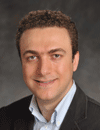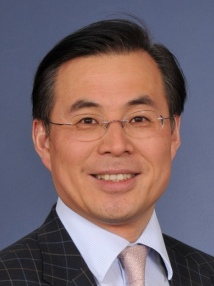
Tuesday, 10 October 201708:30 | Conference Registration, Materials Pick-Up, and Morning Tea and Coffee | |
Biodetection & Biosensors 2017: An Update | | Session Chair: Despina Moschou, Prize Fellow and Lecturer in Bioelectronics, University of Bath, United Kingdom |
| | 09:30 |  | Keynote Presentation Printable Paper-Based Point-of-Care Aptasensors for Biomedical Monitoring
John Brennan, Professor and Director, Biointerfaces Institute, McMaster University, Canada
The talk will focus on the development of printable components to produce easily manufactured bioactive paper sensors with a range of capabilities, including integrated sample preparation, aptamer-based biorecognition, isotrhermal DNA amplification and text-based readout technologies. Examples will be provided to demonstrate multi-step reactions on paper for ultra-sensitive detection of infectious organisms and cancer biomarkers. |
| 10:15 | Detection of Cells and Bacteria Using Surface-Imprinted Polymer Receptors
Patrick Wagner, Professor, Soft-Matter Physics and Biophysics Section, Departement Natuurkunde en Sterrenkunde, Katholieke Universiteit Leuven, Belgium
In this presentation I will first give an overview on the heat-transfer method HTM as a novel biodetection principle and on synthetic whole-cell receptors created by surface imprinting of polymers. Combining both elements allows for the sensitive and surprisingly selective detection of cells and micro-organisms down to comparatively low concentrations. Also instrumental aspects and the recognition mechanism between cells and the polymer imprints will be discussed. | 10:45 | Biodetection On Board Microchips and Micromotors In Non-Ideal Samples
Alberto Escarpa, Full Professor of Analytical Chemistry, University of Alcalá, Spain
| 11:15 | Coffee and Tea Break and Networking | 11:45 | Venneos’ CAN-Spectroscopy – Cell Analysis Beyond Vision
Jonas Lehmann, Co-Founder & Managing Director, Venneos GmbH, Germany
Venneos’ Technology CAN-Spectroscopy brings the analysis of cell based assays to the next level by uniting the advantages of microscopy and impedance spectroscopy. During this talk, a short introduction will be given. | 12:15 |  | Keynote Presentation Biosensors, Sensors and Microfluidic Devices – Key Technologies to Enable Real-Time Patient Monitoring and Treatment
Martyn Boutelle, Professor of Biomedical Sensors Engineering, Imperial College London, United Kingdom
Clinical practice is beginning to wake upto the potential of real-time molecular information from venerable tissue as a means to understand the progression in the tissue of injury or disease. Such patterns of molecular changes, particularly when combined with paternal of physical of electrical signatures, offer the exciting possibility of allowing clinicians to guide therapy on an individualized basis in real time. Microfluidic lab-on-chip devices coupled to tissue sampling using microdialysis provide an important new way for measuring real-time chemical changes as the low volume flow rates of microdialysis probes are ideally matched to the length scales of microfluidic devices. In this presentation I will describe the combination of miniature electrochemical sensors and biosensors with 3D printed microfluidic devices for transplant organ and patient monitoring. Concentrations of key biomarker molecules can then be determined continuously using either optically or electrochemically, using amperometric, potentiometic and array sensors. Wireless devices allow analysis to take place close to the patient. Droplet-based microfluidics, by digitizing the dialysis stream into discrete low volume samples, both minimizes dispersion allowing very rapid concentration changes to be measured, and allows rapid transport of samples between patient and analysis chip. This talk will overview successful design, optimization, automatic-calibration and use of both continuous flow and droplet-based microfluidic analysis systems for real-time clinical monitoring, using clinical examples from our recent work. |
| 13:00 | Networking Lunch in the Exhibit Hall -- Meet the Exhibitors and View Posters | 13:45 |  | Keynote Presentation The Digital Twin: Toward Bioreactor Modeling Using Deep Analytics
Paul Goodwin, Science Director, GE Healthcare, United States of America
By combining new biosensors and analytics we seek to improve the predictability and efficiencies of bioreactors used in bioproduction and cell-therapy. A thorough understanding of each bioreactor will require improvements in sensors to deliver higher performance under stringent biologic, physical, and financial constraints. |
| 14:30 |  | Keynote Presentation Recent Advances in Sensors for mHealthcare
Christopher Lowe, Professor, University of Cambridge, Director, Cambridge Academy of Therapeutic Sciences, United Kingdom
This talk will discuss the motivation behind the global interest in introducing mobile healthcare systems, including the myriad constraints felt by healthcare systems in both developed and developing nations, high population growth, disease prevalence and the rapid rise in mobile phone penetration in developing nations. The concept of lifetime diagnostic and disease management, the types of physiological and biochemical parameters to be measured and the challenges in making discrete and real-time measurements on patients using non-invasive, minimally invasive and invasive sensor technologies will be covered. Examples will be given from various sensor technologies being developed in the speaker’s laboratory in Cambridge. |
| 15:15 | Singlet Oxygen-based Electrosensing
Karolien De Wael, Full Professor, Antwerp University, Belgium
It is well known that phenolic compounds and, particularly, hydroquinone can shuttle electrons between horse radish peroxidase (HRP) and an electrode, which allows the bioelectrocatalytical reduction of H2O2 by the enzyme. When a phenolic compound shuttles the electrons, it passes through many cycles of oxidation and electrochemical reduction (regeneration) near the electrode. Such mechanism enhances the electrochemical response of the compound and has been employed for the electrochemical detection of phenols and their derivatives. However, H2O2 as an oxidant must be introduced into the system, which is an obvious limitation of the method. Our solution is to replace the enzyme with a photosensitizer which produces reactive oxygen species and can catalyze the oxidation of a compound of interest by O2 that is naturally present in the measuring conditions. Here we used a fluorinated phthalocyanine complex of Zn which is capable to form singlet oxygen under red light illumination (? ca. 650 nm). | 15:45 | Afternoon Coffee and Tea Break and Networking | 16:15 | Biosensors with Capacitive Field-Effect Devices – Selected Examples
Michael Schöning, Professor and Director, Institute of Nano- and Biotechnologies, Aachen University of Applied Sciences, Germany
Among the multitude of concepts and different types of chemical sensors and biosensors discussed in literature, the strategy to integrate chemical or biological recognition elements together with semiconductor-type field-effect devices is one of the most attractive approaches. In this context, two examples of capacitive field-effect devices (FEDs), which have been developed recently in our institute, will be presented:
[a]. A DNA- (deoxyribonucleic acid) based FED modified with a positively charged weak polyelectrolyte layer has been applied for the electrical detection of DNA immobilization and hybridization by the intrinsic molecular charge. This biosensor is able to detect the existence of target DNA amplicons in PCR (polymerase chain reaction) samples and thus, can be used as tool for a quick verification of DNA amplification and the successful PCR process.
[b]. As a second example, a TMV- (tobacco mosaic virus) modified FED for penicillin detection is presented. The TMV nanotubes serve as enzyme nanocarriers, enabling the immobilization of a high amount of enzymes without substantial loss of their activity, which results in an enhanced biosensor performance. This approach has been experimentally demonstrated by realizing a penicillin biosensor using TMV nanotubes functionalized with the enzyme penicillinase as a model system.
| 16:45 | Surface Molecular Imprints: A Versatile Tool for Biomimetic Detection
Peter Lieberzeit, Professor, University of Vienna, Austria
Surface imprinting into forming polymer layers and particles leads to highly selective artificial receptors for binding and sensing biological species, including proteins, bacteria and viruses. | 17:15 | Point of Care Diagnostics Based on Organic and Printed Electronics
Tony Killard, Professor of Biomedical Sciences, University of the West of England, United Kingdom
Point of care diagnostics was completely revolutionised through the mass production of printed sensor strips in combination with electrochemical transduction. Glucose biosensors could be considered ahead of their time in the field of organic and printed electronics. With the development of a broad array of new functional materials with characteristics such as organic, nanostructured solution processability, in combination with printing and low cost 2D and 3D system integration approaches, the field is now developing rapidly, allowing the fabrication of novel, integrated systems for new diagnostic applications. Our research group has been developing a number of point-of-care diagnostic devices based on the application and integration of electrochemical sensors in organic and printed electronics. Impedimetric sensors based on inkjet-printed polyaniline nanoparticle-modified electrodes have been used as the basis of a breath diagnostic device for measuring breath ammonia. The sensors were capable of measuring ammonia down to several parts per billion in human breath and were studied in haemodialysis patients.2 This technology is being commercialised and being used to address a number of healthcare challenges. This concept has also been extended to the measurement of ammonia in blood, which has remained a challenging analyte in point of care diagnostics. Other print-processable materials are now also being developed to measure other trace breath gases such as acetone for monitoring diabetes. | 17:45 | Impedimetric and Field-Effect DNA and Peptide Aptamer Sensors for Medical and Environmental Applications
Pedro Estrela, Associate Professor, Department of Electronic & Electrical Engineering, University of Bath, United Kingdom
There is a great need for low-cost intelligent biochips capable of massive parallel detection to be used in portable instrumentation. Electrochemical methods are inherently low-cost, miniaturisable and easily integrated into multiplexed systems for the parallel screening of a panel of biomarkers. Of particular interest are biologically sensitive field-effect transistors (BioFETs) and impedance-based sensors. We here exemplify the use of synthetic molecules such as DNA aptamers and peptide aptamers (Affimers), as alternatives to antibodies, in impedance and BioFET sensors for the detection of a range of biomarkers in medical diagnosis and for environmental monitoring. | 18:15 | Close of Day 1 of the Conference |
Wednesday, 11 October 201708:30 | Morning Coffee, Tea and Networking | |
Session Title: The Impact of Microfluidics and POC Diagnostics into the Biodetection Space |
| | 09:00 | Lab on Discs for Diagnostics and Process Control
Anja Boisen, Professor, Department of Micro and Nanotechnology, Technical University of Denmark, Denmark
The optics and mechanics from a DVD player can be used to realize compact and sensitive sensor systems. By rotating a disc with integrated microfluidic channels it is possible to manipulate liquid samples such as blood – performing crucial operations like separation, valving and mixing. We integrate cantilever-based sensors, electrochemistry, surface enhanced Raman spectroscopy (SERS), nanoparticles and resonating strings with centrifugal microfluidics. The sensors are read out by a DVD pick-up head which can perform transmission, absorption measurements and which can detect nm deflections. Also, electrodes are integrated on a disc platform, facilitating the electrochemical measurements. Applications within diagnostics and process monitoring will be highlighted. | 09:30 |  | Keynote Presentation Wearable Electrochemical Sensors: Toward Lab on the Skin
Joseph Wang, Distinguished Professor, SAIC Endowed Chair, University of California-San Diego, United States of America
This presentation will discuss recent developments in the field of wearable electrochemical sensors integrated directly onto both textile materials and on the epidermis for various non-invasive monitoring applications. |
| 10:15 | Bioinspired Microfluidics
Dermot Diamond, Professor, Principal Investigator, Insight Centre for Data Analytics, National Centre for Sensor Research, Dublin City University, Ireland
Microfluidics will transform from engineering inspired 2D largely passive systems to Bioinspired 3D systems incorporating advanced functionalities such as self-awareness and self-maintenance. These features will be incorporated through incorporation of stimuli-responsive materials exhibiting biomimetic characteristics. | 10:45 | Coffee, Tea and Networking | 11:15 | Magnetic Bead Based Detection of Biomarkers by Phase Shift Measurement in Complex Sample Matrices
Stefan Scheuermann, Researcher, Fraunhofer IPA, Germany
BeadTRAP - a highly efficient detection technology for the direct measurement of biomarkers in complex samples. The technology is based on alternating magnetic fields forcing magnetic particles into oscillation, combining the power of purification with highly sensitive detection of biomarkers. | 11:45 | Planar Waveguide Biosensor Technology for Next Generation Point of Care Diagnostics
Reuven Duer, Founder & CEO, Proactive Diagnostics, United States of America
I’ll be presenting a novel and disruptive detection technology for Point of Care diagnostics. The presentation includes the underlying physics, implementation solutions and testing data of this unique technology platform. | 12:15 | Plasmonic Nanopores for Analysis and Detection of Biomolecules
Andreas Dahlin, Associate Professor, Chalmers University of Technology, Sweden
Plasmonic nanostructures have been used in biosensor applications for over 10 years. Following advancements in nanofabrication techniques, more and more complex structures have been developed. Still, the commercial technique of surface plasmon resonance remains the golden standard for studying biomolecular interactions by refractive index changes on a surface. This is mainly because no nanofabrication is needed as the method only utilizes a planar thin gold film and the resolution in surface coverage is very high (below 0.1 ng/cm2). However, one can envision unique advantages of nanostructured sensor surfaces based on utilizing the structure itself. In this talk I will give examples of such applications based on plasmonic nanopores, i.e. nanoscale apertures in thin gold films. For instance, I will describe how polymer-functionalized nanopores act as molecular filters or nanoscale sieves, offering the possibility to isolate small molecules to be detected from complex mixtures. This can be utilized to improve specificity in detection of small analytes. Various other applications where the plasmonic nanopores provide special benefits will also be presented. | 12:45 | Networking Lunch in the Exhibit Hall -- Meet the Exhibitors and View Posters | 13:30 | TB or not TB
Chris Adams, Head of Biosensor, QuantumDx, Ltd., United Kingdom
With 8.6 million new cases diagnosed every year, and an estimated 3 million unreported cases in remote village locations, TB is still a leading cause of death worldwide. This, combined with increasing levels of drug resistance, means that the need for a portable device able to deliver accurate 15-20 minute turnaround DNA-based classification is ever more acute. Chris Adams, Head of Biosensor Development at QuantuMDx, will present the company’s development of a handheld sample-to-result device that will make personalised medicine affordable and accessible, even in resource scarce settings. The device delivers referral laboratory-standard results at the point of care. It is operated simply and with on-board power. The device performs DNA extraction, PCR and either multiplex label-free microarray detection using a silicon nanowire or optical based assays QuantuMDx has also developed a novel DNA sequencing technology for possible de novo or discovery application of the technology in the future. Excitingly the company has recently hit the significant milestone of full integration of the platform in an beta prototype. Clinical trials are expected to kick off later this year, with commercialisation expected in 2018.
| 14:00 |  From Academia to Commercialization – A Case Study From Academia to Commercialization – A Case Study
Martin Peacock, Director, Zimmer and Peacock
We use a Zimmer and Peacock case study, where we have partnered with a UK University to commercialize their technology, and offer this as a template to work with other academic and start-up teams to commercialize their technology.
| 14:30 | Magneto-Optical Sensing at Point-of-Need
Jenna Bowen, Co-Founder, Cotton Mouton Diagnostics Ltd., United Kingdom
First developed as an in-field diagnostic for malaria, CMD’s innovative magneto-optical technology has been transformed into a generic sensing platform capable of detecting a variety of markers. Reduced to a small footprint and capable of providing results within minutes, the CMD system is ideally suited to point-of-need applications across the healthcare sector and beyond. | 15:00 |  | Keynote Presentation Mobile Imaging, Sensing and Diagnostics Using Computational Photonics
Aydogan Ozcan, Chancellor's Professor, University of California-Los Angeles; Associate Director, California NanoSystems Institute (CNSI), United States of America
In this presentation I will discuss some of the emerging applications and the future opportunities created by the use of mobile phones and other consumer electronics devices for the development of next-generation imaging, sensing and diagnostics tools through computational photonics techniques. |
| 15:45 | Controlling and Measuring the Flow of Charged Species through Nanopores
Mark Platt, Senior Lecturer, Loughborough University, United Kingdom
Nanopore technologies offer single particle analysis, being used to sequence DNA, detect proteins, cells or nanomaterials. We review recent results developing multiplexed sensors, using aptamer modified nanomaterials and nanopores for the detection of metal ions, proteins and bacteria. | 16:15 | Use of Synthetic Recognition Elements for the Thermal Sensing of Biomarkers
Marloes Peeters, Deputy Director of Chemical Engineering, Newcastle University, United Kingdom
Molecular Imprinted Polymers (MIPs) are synthetic receptors with recognition sites that are complementary to the template in their size, shape, and orientation of functional groups . These microparticles are synthesized for the neurotransmitter noradrenaline with the optimal composition and binding conditions being determined via optical batch rebinding experiments. Next, the obtained MIPs are mixed within screen-printed inks to produce mass-producible bulk modified MIPs screen-printed electrodes (MIP-SPEs). In this contribution, the supporting surface which the MIP-SPEs are screen-printed upon are explored to deviate from conventional polyester, to polyvinylchloride, tracing paper and household-printing paper. The performance of the MIP-SPEs are measured using the Heat-Transfer Method (HTM), a straightforward and low-cost detection technique based on thermal resistance. At first, the noise on the signal is minimized by adjusting the settings of the temperature feedback loop. Second, the response of the MIP-SPEs to noradrenaline is measured and compared for the different substrate materials. Sensors printed onto paper are considered in further experiments as their response to noradrenaline is the highest and advantageous material properties, including sustainability and flexibility of the material. Subsequently, dose-response curves are determined by simultaneously measuring HTM and Thermal Wave Transport Analysis (TWTA). The latter is a new thermal detection method that relies on the use of thermal waves and has the advantage of a short measurement time (2 min). With these thermal methods, it is possible to specifically detect noradrenaline in aqueous solutions and quantify it at relevant concentrations. In summary, by combining synthetic receptors with thermal measurement techniques it is possible to develop a portable sensor platform that is capable of low-cost and straightforward detection of biomolecules. Through exploring novel SPE substrates, a system is designed that is flexible and holds potential for the use in commercial biomedical devices and complex sensor architectures.
| 16:45 |  | Keynote Presentation Body Sensor Networks: Current State of the Art and Future Directions
Guang-Zhong Yang, Director and Co-Founder of the Hamlyn Centre for Robotic Surgery; Professor, Imperial College London, United Kingdom
Recent advances in surgery have made a significant impact on the management of major acute diseases, prolonging life and continuously pushing the boundaries of survival. Despite increasing sophistication of surgical intervention, complications remain common and poorly understood, contributing significantly to mortality and morbidity. Surgical site infections, catheter related sepsis, wound dehiscence and gastrointestinal anastomotic leakage are recognized complications following surgical interventions or invasive monitoring of critically ill surgical patients. Current methods for detecting these complications rely on episodic clinical examination with 'snap shot' laboratory testing. This talk focusses on the development of new sensing technologies that can be seamlessly integrated with existing surgical appliances to provide continuous sensing and early detection of these adverse events, thus minimizing post-operative infection, complication, and readmission. |
| 17:15 |  | Keynote Presentation Host Biomarker Detection as Diagnostic Indicators of Infection
Karen Kempsell, Senior Project Team Leader, Public Health England, United Kingdom
Host Biomarkers have been used in diagnosis of disease and other conditions for many decades e.g. blood gases, creatinine, CRP, PCT. Clinical diagnoses already rely heavily on these for patient disease management and informing treatment and care pathways. There is a historic precedent for their use e.g. Lateral flow devices (LFDs) e.g. pregnancy test i.e. hCG. Detection of these markers are useful as diagnostic tools, particularly in incidences where infections are hard to diagnose e.g. extra-pulmonary Tuberculosis. The market for biomarker-based biosensor devices is considerable and interest in further diagnostic opportunities is mounting. Here we present evidence to support the use of biomarkers for disease diagnosis and outline translational pipelines and platforms and issues with route to market, particularly for new Tuberculosis diagnostics.
|
| 17:45 | Oxytocin-Enabled Impedimetric Biosensor for Zinc and Copper Ions
Kiran Kumar Tadi, Post-Doctoral Fellow, Institute of Chemistry, The Hebrew University of Jerusalem, Israel
Oxytocin is reported for the first time as a recognition layer of a biosensor. The usefulness of this methodology is validated by differentiating between sera samples of multiple sclerosis patients and healthy ones based on zinc to copper ratio. | 18:15 | Microfluidics & Hypermobility for Health 4.0
Ali Tinazli, Head of Healthcare & Life Sciences Strategy, HP, Inc., United States of America
New imperatives of healthcare are focusing on prevention, personalization of diagnostics and treatment, and democratization, including access to everyone, anywhere, anytime at a low cost. The technology convergence in medicine is enabled by the powerful combination of microelectronics, microfluidics, distributed network and data analytics. | 18:45 | Close of Conference |
|

 Add to Calendar ▼2017-10-10 00:00:002017-10-11 00:00:00Europe/LondonBiodetection and Biosensors 2017Biodetection and Biosensors 2017 in Murray Edwards College, Cambridge, UKMurray Edwards College, Cambridge, UKSELECTBIOenquiries@selectbiosciences.com
Add to Calendar ▼2017-10-10 00:00:002017-10-11 00:00:00Europe/LondonBiodetection and Biosensors 2017Biodetection and Biosensors 2017 in Murray Edwards College, Cambridge, UKMurray Edwards College, Cambridge, UKSELECTBIOenquiries@selectbiosciences.com